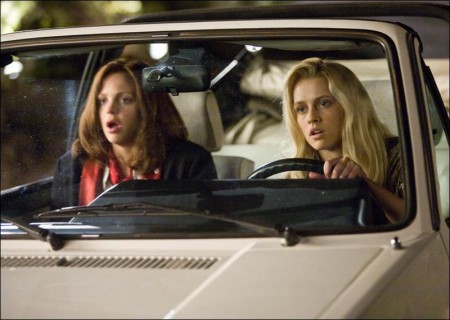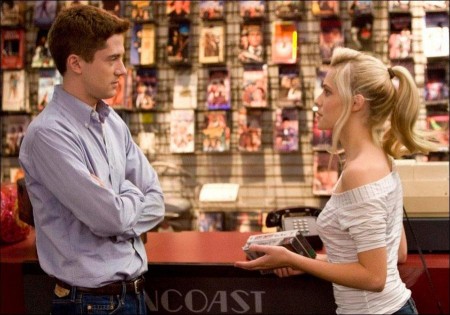Taglines: Best. Night. Ever.
As the summer of 1988 winds down, three friends on the verge of adulthood attend an out-of-control party in celebration of their last night of unbridled youth. Starring Topher Grace, Anna Faris, Dan Fogler and Teresa Palmer, Take Me Home Tonight is a raunchy, romantic and ultimately touching blast from the past set to an awesome soundtrack of timeless rock and hip-hop hits.
Recent MIT grad Matt Franklin should be working for a Fortune 500 company and starting his upward climb to full-fledged yuppie-hood. Instead, the directionless 23-year-old takes a part-time job behind the counter of a video store at the Sherman Oaks Galleria. But, Matt’s silent protest against maturity comes to a screeching halt once his unrequited high school crush, Tori Frederking, walks into the store.
When she invites him to an epic, end-of-summer party, Matt thinks he finally might have a chance with the girl of his dreams. With his cynical twin sister Wendy and best friend Barry, Matt embarks on a once-in-a-lifetime evening that will change the course of their lives on one unforgettable night in the Go-Go ’80s.
About the Production
Take Me Home Tonight producers Topher Grace and Gordon Kaywin have been best friends since they met at the age of 15. After high school, the pair set out for California to attend college and pursue their show business dreams. Grace left the University of Southern California after his first year to star in the popular sitcom “That ’70s Show.” But he and Kaywin continued to develop concepts for their own projects, including one inspired by the close relationship they had developed in high school. That initial kernel became the basis for Take Me Home Tonight.
“Gordon and I were roommates in boarding school, so we have a lot of history,” says Grace. “We’ve developed a shorthand when we talk to each other. We wanted to focus on the sort of second puberty that happens when kids get out of college today. Their whole life has been planned for them to this point and then they’re suddenly directionless. We decided the best place to set that would be in the go-go ’80s.”
In Take Me Home Tonight, Matt Franklin, played by Grace, is facing exactly that dilemma. After graduating with an engineering degree from MIT, he’s paralyzed as he tries to figure out what he’s going to do next. On one long end-of-summer night, Matt comes to the realization that it’s okay not to know exactly what he’s going to do for the rest of his life.
“We were a lot like Matt when we were younger,” says Kaywin. “And we knew guys like Kyle and Barry, and girls like Wendy and Tori, the other main characters in the film. None of us are from L.A., but at that time in our lives, we were discovering what it was about and what it was like to live here.”
The partners were inspired by some of their favorite movies from the 1980s, which featured young ensemble casts and plots that revolved around everyday events. “They were what I think of as ‘low-concept’ movies,” says Kaywin. “By that I mean you can’t easily pitch them in one sentence. We wanted to do a film with a group of up-and-coming young people that deals with one important night in their lives.”
“I don’t see a lot of movies today that are allowing young actors to do their thing,” adds Grace. “We made a movie with great actors, but no huge marquee stars. And I think there’s nothing more exciting to audiences than something or someone new.”
In homage to their inspiration, they chose to set the film in 1988, but the story could take place at any time, says Grace. “The film focuses on universal themes about young people trying to figure out their futures. The characters are completely accessible to today’s audience. Everyone knows a Kyle or a Barry or a Wendy. People will be able to grab on to recognizable characters and themes that make the film timeless.”
As they developed their idea, the first-time filmmakers were fortunate enough to garner the support of two of Hollywood’s biggest guns: Brian Grazer and Ron Howard of Imagine Entertainment. “Being mentored through our first experience as producers by the people at Imagine is a tremendous advantage,” says Kaywin.
“Ron Howard and Brian Grazer have had so many successes,” adds Grace. “We’re hoping some of their greatness rubs off on us. We’ve never done anything like this before and it can be intimidating. We want to do it the right way, so it has been great to be with people that could guide us through the process.”
When Grace and Kaywin began working with Imagine, all they had was the basic idea for the film and the main characters. With the help of the legendary production company, they conducted an intensive search for a screenwriter to take their film from concept to fully fleshed-out script. “I think we met with every writer in town,” says Grace. During his seven seasons on the popular sitcom, “That ’70s Show,” Grace had worked with writers Jackie and Jeff Filgow, whose work he continued to admire. “Sitcoms are sometimes looked down upon when compared to movies,” he says. “But their dialogue was so much sharper and funnier than a lot of the stuff we were reading. So I called Jackie and Jeff, and they had a great take on the movie.”
Grace, Kaywin and the Filgows sat down with Imagine’s Vice President of motion pictures Sara Bowen and Executive Producer Jim Whittaker to nail down the major beats of the film. The next step was to bring in a director. “John Hughes would have been the guy to go to back in the day,” Grace says. “We wanted someone who could service both what’s funny and what’s moving about the story.”
“We also wanted someone who understood that we weren’t trying to make fun of the ’80s,” says Kaywin. “This isn’t a movie that is trying to spoof the time-period. In fact, we wanted it to seem almost as if it had been made in the ’80s.”
“We wanted it to feel as if it had been locked away in a vault,” says Grace. “We wanted the sound track to have a synthesizer in it, something that is never used today. We wanted the structure and the ensemble to feel the way films felt in the ’80s. And yet we also wanted it to have an undercurrent of what we know happened in the 20 years following this film. And Mike Dowse felt the exact same way.”
The director of Fubar and Fubar II, a pair of screwball mockumentaries about a couple of hard-partying Calgary headbangers, Dowse instantly understood the producers’ point of view and had strong ideas about how to implement it. “He’s incredibly visual,” says Kaywin. “His ideas about how to shoot the film were very unconventional in terms of how comedies are usually shot. During filming, Topher and I were always kicking each other, because he was executing the storytelling through the camera in a way that isn’t done in comedies very often. Michael surpassed anything we could have imagined.”
“The way he shot allows the audiences to see things from Matt’s point of view,” adds Grace. “When you read the script, it’s very straightforward. But Michael took it to another level. You’re not just hearing it and seeing it—you’re actually feeling it.”
Dowse found he was able to relate to many elements of the script and to bring some of his own experiences to making it come alive onscreen. “In 1988, I was 15 years old and going into 10th grade,” he says. “So I responded to that time period. I was able to romanticize it a little bit, because those were some of my most awkward years. I was a little younger than the kids in the movie, but I definitely had a good feel for that time, and for the music, the fashion and what people were into.
“Historically, 1988 was a transitional year,” he continues. “Communism was failing. The first President Bush was about to take office. There was starting to be a real shift in music out of the more pop sound of the ’80s into hardcore rap. Grunge is right around the corner. There’s a real shift in mentality going on.”
Dowse grew up in Calgary, the site of the 1988 Winter Olympics, so the film’s Los Angeles setting was glamorous and exotic to him. “L.A. was always like Shangri-la in movies,” he remembers. “It was also enticing to make an ensemble piece with a group of rising young actors.”
Dowse and Grace spent a week together dissecting the script, further defining the plot and characters. “I worked very closely with Topher in terms of script development,” the director says. “It was great to have a bunch of balls in the air narratively. And it’s a lot of fun to play with the limitations of telling a story that takes place in a 24-hour time period. You can go into depth and take a bit more time with scenes.”
Take Me Home Tonight
Directed by: Michael Dowse
Starring: Topher Grace, Michelle Trachtenberg, Anna Faris, Dan Fogler, Teresa Palmer, Chris Pratt, Lucy Punch, Michelle Trachtenberg, Jeanie Hackett
Screenplay by: Jackie Filgo
Production Design by: William Arnold
Cinematography by: Terry Stacey
Film Editing by: Lee Haxall
Costume Design by: Carol Oditz
Set Decoration by: David Smith, Donna Stamps
Art Direction by: Elliott Glick
Music by: Trevor Horn
MPAA Rating: R for language, sexual content and drug use.
Studio: Relativity Media
Release Date: March 4, 2011
Hits: 93







